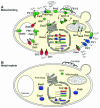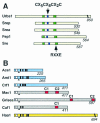Metal-responsive transcription factors that regulate iron, zinc, and copper homeostasis in eukaryotic cells
- PMID: 14871932
- PMCID: PMC329510
- DOI: 10.1128/EC.3.1.1-13.2004
Metal-responsive transcription factors that regulate iron, zinc, and copper homeostasis in eukaryotic cells
Figures



References
-
- Adilakshmi, T., and R. O. Laine. 2002. Ribosomal protein S25 mRNA partners with MTF-1 and La to provide a p53-mediated mechanism for survival or death. J. Biol. Chem. 277:4147-4151. - PubMed
-
- Andrews, G. K. 2001. Cellular zinc sensors: MTF-1 regulation of gene expression. Biometals 14:223-237. - PubMed
-
- Andrews, G. K., D. K. Lee, R. Ravindra, P. Lichtlen, M. Sirito, M. Sawadogo, and W. Schaffner. 2001. The transcription factors MTF-1 and USF1 cooperate to regulate mouse metallothionein-I expression in response to the essential metal zinc in visceral endoderm cells during early development. EMBO J. 20:1114-1122. - PMC - PubMed
Publication types
MeSH terms
Substances
Grants and funding
LinkOut - more resources
Full Text Sources
Other Literature Sources
Medical
Molecular Biology Databases

